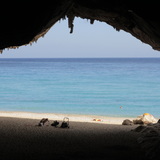🧗♀️⛰ Cala Luna is a large beach, characterized by five huge grottoes. The rock is overhanging with pumpy routes, with very athletic movements. As a downside, the rock gets greasy with the sea salt, especially when the scirocco wind blows.
The climbing area on the beach of Cala Luna is at the same time the most BEAUTIFUL and most DANGEROUS place where one can climb. If many years ago Cala Luna represented a dream destination for climbers, oxidation has made all bolts insecure and the often-greasy conditions of the rock make it a death trap for unaware climbers. Just like all other sea-side cliffs, salt and heat damage metals in no time at all.
Why not re-bolting in Titanium? Cala Luna was first bolted without asking permission from the local administration. Unfortunately, it is a protected landmark, also exposed to rock falls. Therefore, it cannot receive permission to be re-bolted and its destiny may be the complete removal of all equipment.
🌞 BEST SEASON
Rather than the heath, the problem with Cala Luna is humidity. It is best to climb when the sky is blue and dry. The best wind is Mistral, which blows all humidity away. During hot summer days, the rock becomes greasy. It is very important not to go to Cala Luna when the Scirocco wind blows and the line of the horizon is not straight and crispy.


